This Superconducting Experiment Just Broke Physics

Researchers just witnessed a superconductor behavior that defies our current understanding of physics.
At a certain electron density, quantum fluctuations—the phenomena that make superconductors stop being superconductors—just… stop.
The team behind this discovery has no idea why it happens, but looks forward to finding new physics to explain their discovery.
When ice melts into water, it changes. It behaves differently, it moves differently, and the atoms are organized differently. These are all effects of a phase change, and while they don’t change what a material is, they can definitely change how it works.
The same thing—or at least a similar thing—happens in the quantum realm, and these quantum phase changes are extremely interested to researchers studying superconductors. “How a superconducting phase can be changed to another phase is an intriguing area of study,” Sanfeng Wu, who studies these transitions, said in a press release. “And we have been interested in this problem in atomically thin, clean, and single crystalline materials for a while.”
In order to turn that interest into more scientific knowledge, as the research team describes in a study recently published in the journal Nature Physics, they turned to a material known as tungsten ditelluride and shaved it down until it was just three atoms thick. Then, they made it cold. Really cold. -459.58 F° cold.
One it was cold enough, the team added a few extra electrons to the material and made themselves a superconductor. “Just a tiny amount of gate voltage can change the material from an insulator to a superconductor,” Tiancheng Song, lead author of the paper, said in a press release. “This is really a remarkable effect.”
But it wasn’t the only remarkable effect. It turns out that at certain electron densities, something really weird happened—something the team was really not expecting.
See, in this study, the team wanted to take a close look something called quantum fluctuations. They occur right at the threshold between superconductor and non-superconductor, and they destroy superconductivity. Superconductivity is an inherently organized state of being, and fluctuations are the exact opposite. Bring on the fluctuations, you kill the superconductivity.
So, the team wanted to get a good look at these disruptive little buggers. In order to do so, they heated one side of their material until it was no longer behaving as a superconductor, but instead acting as an insulator. This causes the quantum fluctuations to produce quantum vortices—little whirlpools of magnetic field that researchers can track to study fluctuations.
Throughout this entire experiment, the team had been maintaining a certain density of electrons flowing through the material. And after they established their gradient, they began to change those density levels. And here’s where it gets weird: at a certain density, the quantum fluctuations just… stopped. Poof.
And no one knows why. According to physics as we know it, that really shouldn’t have happened. “We expected to see strong fluctuations persist below the critical electron density on the non-superconducting side, just like the strong fluctuations seen well above the BKT transition temperature,” Wu said in the press release. “Yet, what we found was that the vortex signals ‘suddenly’ vanish the moment the critical electron density is crossed. And this was a shock. We can’t explain at all this observation—the ‘sudden death’ of the fluctuations.”
If particle physicists are saying they have no idea what’s going on, things have gotten really complicated. As Wu told Popular Mechanics in an email, this situation “requires new understanding of the superconducting quantum phase transition.”
All new understanding. That’ll certainly be an exciting puzzle for the team to try and solve.
You Might Also Like

